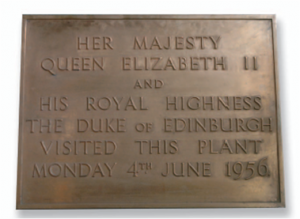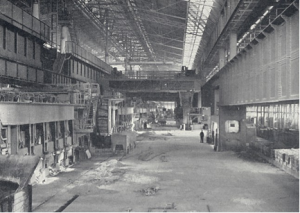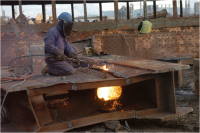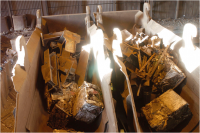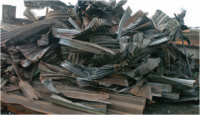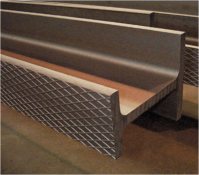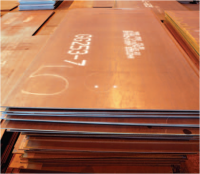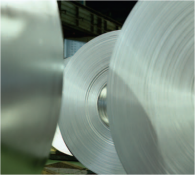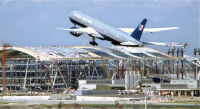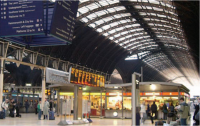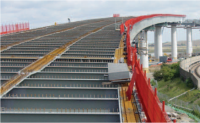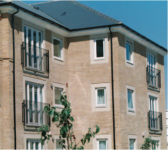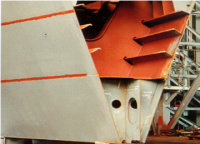Lackenby open hearth steel plant
Built in 1953, the Lackenby open hearth steel plant was a huge building. Over 330 metres long, 39 metres high and with a width of 70 metres and incorporating over 20,000 tonnes of structural steelwork, it dominated the Tata Steel site at Teesside. Opened in 1956 by HM Queen Elizabeth II it remained in production for over twenty years. After that time, the huge volumes and large, column-free spaces made it ideal for conversion to a material storage facility. But by 2004, the building had come to the end of its useful life and it was marked for demolition.
The decision was taken to use explosive demolition with the scrap steel being recycled back into the furnaces on the site. The option for dismantling and re-use of the steel was considered but there were three reasons why this was not possible:
- Lack of safe access
- The building was constructed using welded and riveted joints and not the bolted connections, which make disassembly possible in modern construction
- The building had been designed using non-standard sections
Scrap is critical to the manufacture of new steel. Over 45% of all steel is manufactured directly from scrap and all steel products include some recycled content. Because of this it has a very high value, a fact that ensures almost all scrap steel that becomes available is collected. Worldwide, it is estimated that the recovery rate is over 80%. Scrap steel is money in the bank. This value is enhanced because steel reaching the end of its life is 100% recyclable and the possibilities for making new products are endless. This means that most of the world's steel is kept in continuous circulation.
Recycling also reduces waste. In 2008, Construction and demolition waste accounted for 35% of the total arising in the UK[1] and diverting waste from landfill is a key priority for the construction industry. Because of the high residual value, 99% of scrap derived from structural steel used in construction is either re-used or recycled. Less than one per cent of steel sections are lost. Recycling displaces production made from virgin sources. This saves on raw material resources and energy and also means that emissions of greenhouse gases, such as carbon dioxide, are reduced.
| Product | % Reused | % Recycled | % Lost |
| Heavy structural sections/tubes1 | 7 | 93 | 0 |
| Rebar (in concrete superstructures) | 0 | 98 | 2 |
| Rebar (in concrete sub-structure or foundations) | 2 | 95 | 2 |
| Steel piles (sheet and bearing) | 15 | 71 | 14 |
| Light structural steel | 5 | 93 | 2 |
| Profile steel cladding (roof/facade) | 10 | 89 | 1 |
| Internal light steel (e.g. plaster profiles, door frames) | 0 | 94 | 6 |
| Other (e.g. stainless steel) | 4 | 95 | 1 |
| Average (across all products) | 5 | 91 | 4 |
Summary of reuse and recycling rate from a 2012 Eurofer survey (with additional responses)
1For practical purposes a 99% recycling/reuse rate is generally assumed to account for small losses of material during the lifecycle of the product.
Once demolished by controlled explosion, the building materials were recovered from the site, along with other materials such as copper cabling. 100% of the steel was recovered from the site and 100% was recycled. This includes the rebar in the floor construction. The concrete from the floor construction was crushed and used as a low-grade infill material.
On removal from the site, the scrap was taken to the scrap bays, cut to furnace-sized lengths and re-melted over a period of months.
The recycling of steel from the Lackenby steel plant saved enough energy to supply 3700 households with their energy requirements for a year. The new steel was manufactured as sections, plates and strip and used in a wide range of new products.
The scrap steel was cut to size and supplied to Tata Steel’s steelmaking site over a six-month period. During this time new steel, to which this scrap contributed, was supplied to hundreds of customers for a wide variety of end uses:
- The manufacture of structural sections used in the construction of Heathrow Terminal 5.
- The manufacture of structural sections used in the construction of the new stand at the Oval cricket ground.
- The manufacture of plates used in the construction of buildings over Paddington.
- The manufacture of plates, fabricated into large girders for the A249 bridge to the Isle of Sheppey.
- The manufacture of galvanised strip steel to make light steel-framed houses.
- The manufacture of strip steel, supplied to the Royal Mint to make copper plated 1p and 2p coins.
- The manufacture of strip steel for automotive parts.
- The manufacture of plates, tailor made into bulb flats used in the construction of ships.
- Where the recycled steel went




